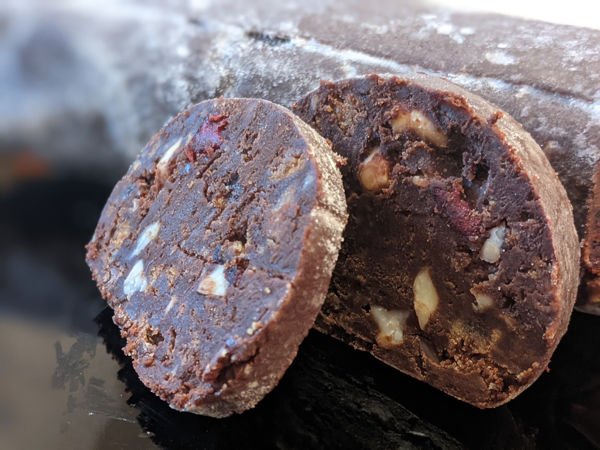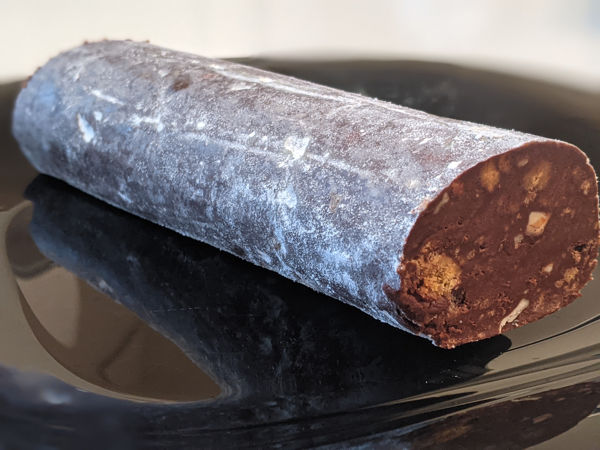I have to admit that in the beginning, I thought this was a very strange recipe. A sweet salame? Made of chocolate? When I first learned about it (three months ago) it made no sense and sounded like a joke. But as I came back to it at the end of this project, after learning a bit more about the spirit of Italian cuisine, it makes more sense. Not only that: I loved it 😊.
I hadn’t pick this recipe at the start of the challenge, but just because it didn’t make it to the 12 final recipes. Instead of this one I had intended to prepared the vegan version of the zeppole. But that didn’t work out! 😅 I tried twice doing the zeppole, with two different recipes. The first try was aborted even before it got into the oven. The second didn’t turn out as I expected. It was that bad that I couldn’t even eat it. And now, back to the salami!
Recipe of the Week: Salame di Cioccolato
Beyond the strangeness of this recipe, one thing that I liked is the visual aspect. I’ve always wanted to do a vegan version of salami, with that beautiful white coating. I never thought I would make it with powdered sugar, in a sweet recipe 😁. Even though this is usually eaten at Christmas and at the end of the year, it’s great at other times as well. I watched a couple vegan versions and ended up choosing the one you’ll find below for a couple reasons. The first one was the coating. The other alternatives were presented just with the parchment paper used to press the salame. The second is that it looked more colorful than the other I had seen.
To prepare this salame I had to change a couple things to make it work with what I had available. Instead of using regular vanilla cookies, I used a brand of pumpkin cookies with had other mixed species and chocolate chips. I think it went great with this particular recipe. Somehow, I think this was an improvement (pumpkin and chocolate pair up really well). The other replacement was using dried cranberries instead of the goji berries the recipe originally called for. The red of the cranberries is not as bright as the one you’d find in the goji berries, but it was good enough. The cranberries also go fantastic with chocolate 😊.
So, the lesson with this recipe is that sometimes it’s okay to change gears and do another thing (a completely different recipe, or replace ingredients with what you have at hand), instead of what we originally had set our minds to 🙂.

New Vocabulary
I added 9 new cards to my Anki deck, based on new words and expressions used on the YouTube videos used for this recipe. There were some words in this list that I already know, but I want to reinforce them. I used the Google Chrome extension “Learning Languages with YouTube” (from the same creators of “Learning Languages with Netflix”).

Project Wrap-up
This was such a delicious project! 😋 Since turning vegan, I started cooking and enjoying much more the process of learning how to prepare food. I think that was important to open up my curiosity to learn and experiment with the cooking traditions of other countries. The plant-based cuisine asks us to try new things, innovate, find alternatives and to be creative with what we hand at hand. Learning about the Italian traditions -in their vegan forms- was a new discovery of what was possible in the kitchen and with the Italian language.
The highlights of this project were undoubtedly the pizza napoletana and the tiramisù. I dreaded and looked forward to preparing the pizza napoletana. I remember the first time I had all the ingredients ready to go at 2.30am (because it called for 8 hours of leavening, and I wanted to take photos with sunlight at midday -and also eat it as lunch!), but had to leave it for later (a mix of being noisy late at night with my YouTube video recipe and handling all the pots). A couple days later, I decided to get up very early and have a later lunch at around 2.30pm. And this time it worked out 🙃. I never knew it would turn out so well. This was the only recipe that I repeated during the course of the project.
There were other recipes that I thought of doing again, but for some reason or another I didn’t do yet. I see myself doing again the tiramisù, the lasagne (now I also have the option of using the ragù di soia as the filling) and the risotto allo zafferano. I also enjoyed a lot the torta tenerina and the salame di cioccolato (the recipe of this blog post). I would definitely prepare them for special occasions or to treat somebody (-else, or myself 😛). There are recipes I won’t probably do again in the future. But it was good to learn them anyway! Coming across things we don’t like is part of the process of finding out what we enjoy.
I think that this project was perfect for the goal of making it easier to start living the Italian language, instead of just “learning” or “using” it. Of course, I did use the Italian language to prepare all these recipes. I also added new vocabulary and learned about new techniques and discovered new ingredients. But more important than using the language here was getting used to it. Khatzumoto, from All Japanese All The Time (AJATT), summarizes it beautifully with the motto of his website: You don’t know a language, you live it. You don’t learn a language, you get used to it. I have to say that after these three months now I’m getting more used to the Italian language, through cooking 🙂.
Definitely, I expect to continue preparing Italian dishes. At least, as long as I’m able to continue cooking food! It was great to learn these traditional recipes and to do it this way, in their original language. For those of us who really enjoy cooking as a skill, learning the traditional recipes connected to the languages we learn (either in their original form, or in vegan, gluten-free, or whatever variant you feel like) is an enormous pleasure and satisfaction. That’s why I intend to continue doing so 😊.



